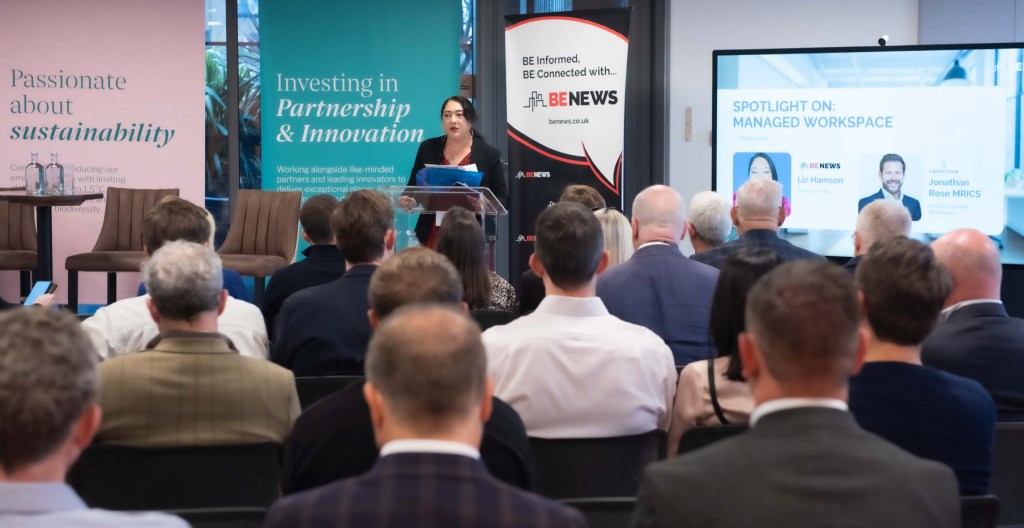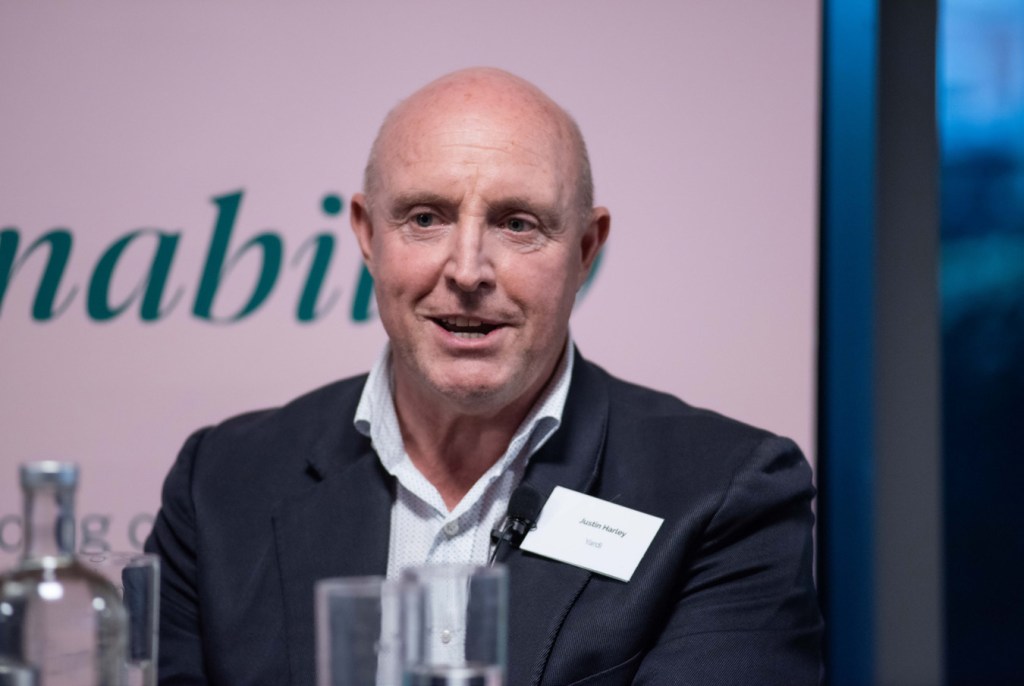Spotlight on Managed Workspace
According to the latest research by managed office operator Kitt, flexible workspace now represents around 10% of total office supply, up from 6% in 2019. And managed workspace accounts for a significant, rapidly growing share of that.
Indeed, 92% of those surveyed for Kitt’s report, The New Office Normal, believe demand for managed offices would grow in the next two to three years. However, around two-thirds of those asked cited valuation uncertainty as a key obstacle, and that is far from the only challenge facing the sector.
So how can the managed workspace model work, what investment returns can be expected, and what role can AI, tech and data play? These were just some of the questions debated during the discussion sponsored by Yardi, Kitt, and Maples Teesdale, and hosted by Grosvenor.

INDUSTRY GUESTS:
- Lisa Cations, Managing Director, JCR Advisors
- Dellah Gilbert, Real Estate Partner and Head of Property Litigation, Maples Teesdale
- Charlie Green, Co-founder, The Office Group (keynote speaker)
- Justin Harley, Senior Director, Yardi
- Lucy Minton, Founder & CCO, Kitt
- Alan Pepper, CEO, Orega
- Jonathan Rose, Head of Flexible Workspace, Grosvenor
- Liz Hamson, Editor-in-Chief, BE News (chair)
Following Grosvenor’s head of flexible workspace, Jonathan Rose’s welcome speech, keynote speaker Charlie Green, co-founder of The Office Group, took to the lectern to share his views on the sector.

Green started by talking about definitions and called managed space “a bridge” between flex space and traditional leasing. However, he said occupiers struggle with industry definitions, with offices typically compartmentalised into coworking, flex, fitted, managed or traditional.
In the simplest terms, an occupier wants an office, and then they decide what form of office they want, where, and how much. Given that every building and every product is different, “You must design your office and your product to fit your building and your audience,” advised Green.
He continued: “This is a tough office market with so many things stacked against you. It is hard, it is competitive, and you have occupiers who want more from their space. That requires more investment. It costs more to create, and it’s hard to get the returns.”

Green concluded with some punchy advice: design – “try to be different”. When it comes to amenities “do it, but don’t obsess about it, make it appropriate to your building” he advised. As for branding, he said, “it’s not about having big [signs] outside the front door, it’s about your route to market, it’s about emotion, culture and experience”.
He signed off by advising operators to focus on net operating income, not rent, and focus on service. “Learn from the hotel sector, but you are not a hotel. We must be service-led, but the demand is not the same [as it is in the hotel sector].”
The panel discussion then got underway, chaired by BE News editor-in-chief Liz Hamson.
QUESTION: What is the definition of ‘managed offices’, and how would you define managed versus flex space?
HARLEY: I try to keep the definition quite simple. Flex space is where amenities are shared, so you want to consider rooms and the kitchens. And then typically managed space is where you have got your own meeting rooms and amenities.

MINTON: The service delivery for a managed space is quite bespoke. It is unique to the company, and our experience tells us that is important. There are companies that have around 20 desks, but often we have got some spaces around 20,000 sq ft, and those companies do not operate in the same way as somebody would if they were taking flex space. Everything about the process needs to be very tailored around what the occupier needs.
CATIONS: Managed offices are typically bespoke workspaces that a landlord or operator designs and runs specifically for a single tenant. The occupier has their own branded environment and autonomy – but without the burden of managing fit-out, maintenance, or services themselves. There is one bill to pay and all the design, fit-out, management and catering is taken care of. By contrast, flexible offices, or ‘flex space’, tends to feel more like being in a shared environment – almost like staying in a hotel.
QUESTION: Have you seen demand for managed office space increase in the past 12 to 18 months?

MINTON: We have seen a real shift in the past 18 months with more traditional players in the industry, both on the landlord and agency side, recognising managed as a legitimate way to deliver a product.
We started life very much in the world of flex brokers, where demand for managed offices was initially generated, but now demand is coming from much more traditional channels than we’ve ever seen before. Volumes are going up, and that is a real sign of the direction of travel.
QUESTION: What is the typical size of a managed workspace?
PEPPER: Probably not under 1,500 sq ft to 2,000 sq ft because at that point it starts to become unfeasible to have your own meeting rooms and kitchens, due to multiple challenges.
That said, from a flex perspective, the demand for occupiers to have their own meeting rooms, even if they only have 10 or 15 desks, is going through the roof.
QUESTION: What are the key differences between flex and managed space in terms of leasing structure?

GILBERT: In terms of flex space, the key is agility, short-term arrangements, and shared amenities.
With managed space, tenants often take space for a longer period – typically between three and five years –and have their own areas that are not shared with anyone else, because they have what is legally called exclusive possession.
Therefore, an all-inclusive short-form lease is a popular option for tenants. The lease for managed space can be negotiated and looks very much like a traditional letting lease, with certain changes – such as a prohibition on alterations – because the fit-out has been provided by companies like Kitt.
There will also be a schedule of conditions relating to that fit-out.
QUESTION: What kind of [investment] returns can you generate from managed offices?
CATIONS: The returns should be more than 8%, but to achieve that, operators really need to “sweat their assets” – making the space as appealing and operationally efficient as possible.

Valuations are increasingly influenced by how well an asset performs, particularly its net operating income (NOI).
Managed offices have a strong case to positively impact valuations, especially when there are direct contracts between the tenant and the landlord with the operator providing a management service.
However, there’s still confusion among landlords about how to differentiate between the returns from managed, flex space and coworking space.
QUESTION: How has Grosvenor’s approach evolved, Jonathan?
ROSE: Our approach has evolved through experience – by testing, learning and refining over time. We started by experimenting with flexible space, testing how much to allocate and how to configure our buildings so they truly work for the people using them.
Over time, we’ve developed a much deeper understanding of layouts, amenities and how to maximise the potential of every asset. With amenities, we’ve made adjustments along the way – sometimes providing too much, sometimes too little – but now we’ve found the right balance.
QUESTION: What are people looking for on the tech front when it comes to managed office space?

HARLEY: If we’re talking about the occupier, they are not really looking for tech – they just want things to work. I don’t think any occupier goes into a place and says, “I really want this kind of technology.” What they want is for it to be frictionless, seamless and work.
Importantly, we are faced with the biggest change ever to happen in the next two or three years, which is artificial intelligence. If you don’t have integrated tech, you’re going to be using AI in silos, whereas the real value will come when it is used right across the organisation.
For investors, two years ago it was all about ESG and now it’s NOI. Everything is about operational efficiency and how do you get better returns.
QUESTION: What do you think is the single biggest challenge currently facing the sector and how do you think it will evolve over the next five years?

ROSE: We’re seeing fairly strong demand for spaces in the 2,000 to 4,000 sq ft range, with more traditional occupiers now considering managed space as a viable option. I expect that trend to continue, and over time we’ll start to see more managed deals above the 5,000 sq ft mark.
The general sentiment is that flex and managed space will keep growing and evolving as new operators enter the market and occupier expectations shift. GILBERT: Institutional investors have got prerequisite returns that they need to achieve, and they like no risk.
The challenge is not just for some of them to get on board, but more of them to get on board to make this mainstream.
For that to happen, there needs to be visibility on metrics and service levels and on valuations. I have absolutely no idea how big the sector will be by 2030. Huge!
Let’s Connect! Follow Yardi Kube on LinkedIn and stay up to date with our latest posts.




